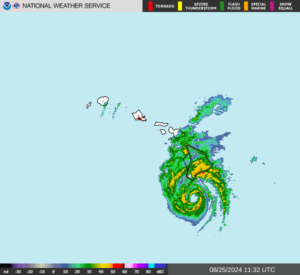Hurricane Gilma continued to churn west toward the Central Pacific Ocean on Monday. At 5:00 p.m. EDT on Monday the center of Hurricane Gilma was located at latitude 18.4°N and longitude 137.4°W which put the center about 1160 miles (2865 km) east of Hilo, Hawaii. Gilma was moving toward the west at 8 m.p.h. (13 km/h). The maximum sustained wind speed was 110 m.p.h. (175 km/h) and there were wind gusts to 130 m.p.h. (210 km/h). The minimum surface pressure was 968 mb.
Hurricane Gilma maintained its intensity on Monday as it churned west toward the Central Pacific. The circulation around Hurricane Gilma was very symmetrical and it exhibited a structure sometimes called an annular hurricane. A circular eye was present at the center of Gilma’s circulation. A ring of thunderstorms surrounded the eye and the strongest winds were occurring in that ring of storms. A several short bands of showers and thunderstorms were revolving around the core of Hurricane Gilma. Storms near the core of Gilma generated upper level divergence that pumped mass away from the hurricane. The divergence of mass in the upper levels of the atmosphere was nearly balanced by the inflow of mass in the lower levels. The balance of mass caused the surface pressure to remain nearly steady.
The circulation around Hurricane Gilma was small. Winds to hurricane force extended out 20 miles (30 km) from the center of Gilma’s circulation. Winds to tropical storm force extended out 80 miles (130 km) from the center of Hurricane Gilma.
Hurricane Gilma will move through an environment that will be marginal for intensification during the next 24 hours. Gilma will move over water where the Sea Surface Temperatures are near 26°C. It will move under the axis of an upper level ridge over the Eastern and Central North Pacific. The upper level winds are weak near the axis of the ridge. Hurricane Gilma is likely to maintain its intensity on Tuesday unless the vertical wind shear increases. Since the circulation around Gilma is small, if the wind shear increases, Hurricane Gilma could start to weaken.
Hurricane Gilma will move around the southern side of a subtropical high pressure system over the Eastern and Central North Pacific Ocean. The high pressure system will steer Gilma toward the west-northwest during the next 24 hours. On its anticipated track, Hurricane Gilma will move closer to Hawaii.
Elsewhere, Tropical Storm Hone moved farther away to the southwest of Hawaii and Tropical Storm Hector moved westward over the Eastern North Pacific Ocean.
At 5:00 p.m. EDT on Monday the center of Tropical Storm Hone was located at latitude 19.2°N and longitude 161.6°W which put the center about 240 miles (385 km) south-southwest of Lihue, Hawaii. Hone was moving toward the west at 13 m.p.h. (20 km/h). The maximum sustained wind speed was 65 m.p.h. (105 km/h) and there were wind gusts to 80 m.p.h. (130 km/h). The minimum surface pressure was 998 mb.
At 5:00 p.m. EDT on Sunday the center of Tropical Storm Hector was located at latitude 16.5°N and longitude 125.8°W which put the center about 1125 miles (1805 km) west-southwest of the southern tip of Baja California. Hector was moving toward the west-northwest at 10 m.p.h. (16 km/h). The maximum sustained wind speed was 50 m.p.h. (80 km/h) and there were wind gusts to 65 m.p.h. (105 km/h). The minimum surface pressure was 998 mb.

